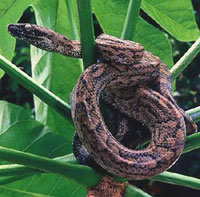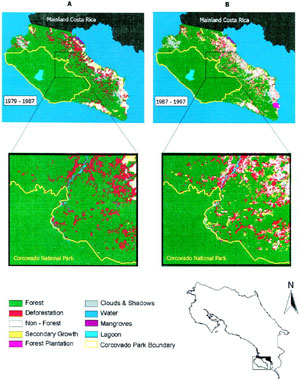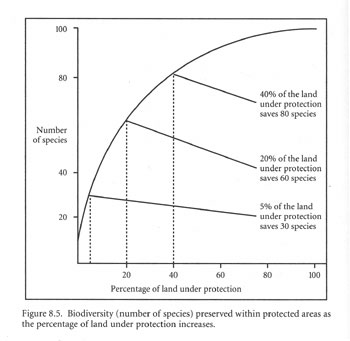Deforestation and biodiversity presentation essay
While the loss of forests is clearly visible, a
decline in biodiversity has a less apparent effect. The subtle loss of
biodiversity fails to indicate the significance that fewer species in the
ecosystem increases the fragility of life for all species. Despite the negative
effects of deforestation and the consequential decline of biodiversity, trees
are cut down for an economic and consumer benefit. Members of society need to
determine how much economic cost they are willing to spend in order to preserve
plant and animal species.
To reduce the degree of deforestation, tree harvesters
may use selective logging, which involves only the removal of trees that are
the most economically beneficial. Trees with lower economic value are left
standing. This method still has problems intrinsic with any kind of
deforestation and selective logging also introduces new environmental problems.
Tree harvesters need to build roads into the forests to remove the timber
(Vandermeer and Perfecto, 1995). The road construction means that a greater
surface of land will be covered by asphalt, which increases the amount of
rainwater runoff that is not filtered by the soil before entering a stream.
These streams are polluted by sediment carried by the rainwater.
Vandermeer and Perfecto also say that selective
logging introduces secondary damage when non-targeted trees are knocked down in
the process of removing the desirable trees. In addition, selective logging
over a long period of time leads to deterioration of the stand, which reduces
the overall value of the forest when the loss of more valuable trees leaves
lower grade timber behind (Vandermeer and Perfecto, 1995).
Another change related to the effect of selective
logging is the changes that occur in the forest when a gap forms due to the
loss of a tree. For tropical rainforests, the hole created by a fallen tree
leads to changes that eventually affect the biodiversity of the habitat. The
tree that previously occupied the space preserved a dark area of land within
the forest. With the canopy of the tree to provide shade gone, light streams in
and causes plants that do better in brighter conditions to force out low light
plants that existed there previously. The loss of low light plants leads to a
decline in biodiversity. Selective logging can bring about this change as well
as the by the work of natural causes, such as storms (Vandermeer and Perfecto,
1995).
Deforestation can directly lead to biodiversity loss
when animal species that live in the trees no longer have their habitat, cannot
relocate, and therefore become extinct. Deforestation can
lead certain tree species to permanently disappear, which affects biodiversity
of plant species in an environment. The effect of deforestation can have the
largest effect in tropical rainforests. According to the NASA Earth
Observatory, half of all 5 to 80 million species live in the rainforests.
Rainforests only make up seven percent of Earth’s total land area, making
these habitats dense with life. Scientists have only named 1.5 million species
in detail but yet about 137 species become extinct daily (Earth Observatory).
Treating biodiversity as important depends on
accepting a model that has a counterargument unconcerned about biodiversity.
The model that de-emphasizes biodiversity can be thought as a complex web of
interconnections. The extinction of one species does not adversely harm other
species or the ecosystem. Species that depended on the now extinct plant or
animal can adapt and find other sources. This model opposes the
biodiversity-dependent house of cards ideal. In this system, it is unclear what
species are linchpins to ecosystem survival but when critical species become
extinct, the entire ecosystem collapses. Other species cannot adapt when
certain forms of life become extinct. The extinction of non-critical species
has no ill effect but creates a false sense of security that any species can
disappear without problem. However ecosystem failure is possible in this model
when particular species die off. No one is sure which model best represents
nature but it is safer to assume the house of cards model as correct. The
consequence of this model is severe enough where it needs to be considered as a
possible explanation until it is otherwise shown not to be accurate. |
 |
Deforestation has made the Puerto Rican Boa an endangered species.
|
The size of households has an influence on the level
of biodiversity and can serve as a method for maintaining the habitats of
species. A reduction in the number of members of a household has lead to an
increase in the number of households. This decline has been due to more
divorces, an increased number of adults living alone after their children have
moved out, and fewer extended families living in the same dwelling. The
increase in households is possible even when the population declines. A study
in Southeast Asia showed that more households tend to consume additional
resources due to the increased consumption of wood for energy. The harvesting
of wood through deforestation led to a smaller habitat for pandas (State
Department, 2003).
Biodiversity is also related to global warming. Slow
growth forests can take in a significant amount of carbon dioxide but
deforestation immediately cuts the contribution to this important environmental
function. When trees grow again on the deforested land, they are replaced by
fast growth forests, which have a reduced ability to uptake carbon dioxide compared
to the slow growth forests. The loss of the slow growth trees reduces the
biodiversity and contributes to global warming (Vandermeer and Perfecto, 1995).
Increased levels of carbon dioxide in the atmosphere trap more sunlight and
raise the Earth’s temperature.
For solutions to the biodiversity problem,
Sanchez-Azofeifa et al. studied
deforestation near national parks. They concluded that national parks were a
good starting point for conversation but they were not sufficient for species
that need large habitat spaces in order to remain genetically stable
(Sanchez-Azofeifa et al., 2002). From this finding the
government could implement solutions to maintain biodiversity by establishing
additional national parks. They could also tax companies that deforest and
provide subsidies to companies that find alternatives to deforestation.
Corporations could preserve biodiversity by finding sustainable methods for
their use of resources. Biodiversity would benefit from individuals who choose
to live in areas that have already been developed, reducing the need to clear
additional forests.
Southwick’s solutions for deforestation, which
would in turn help biodiversity, include awareness campaigns, forest
conservation efforts, and social changes. For awareness, Southwick would like
to see increased public recognition that deforestation is a problem, especially
among business and government leaders. He supports the recycling of forest
products, improved planting methods, and economic development that does not
depend on deforestation. Southwick sees a need for jobs that are not based on
logging in communities that depend on timber for their economy. Possible
alternative jobs include environmental restoration. Southwick is in favor of
selective logging, but as Vandermeer and Perfecto noted, this method can also
be problematic. Finally, Southwick calls for a general social and economic
restructuring that would reconsider the property rights of forests and the
value of forests (Southwick, 1996). |
 |
The Corcovado National Park in the lower left of these map panels have much more forestland than surrounding unprotected areas.
|
These solutions do not completely address the
problems associated with using the forests for timber. Society has a need and
desire for forest-based products such as paper and wooden furniture. Companies
and individuals need the wood from forests to provide economic prosperity and
employment. With more restrictions on deforestation, the price of wood products
may increase due to a reduction in timber supply. Plastic could be a viable
alternative to wooden products but this synthetic material requires a supply of
oil, which may be in demand for other uses.
Despite the benefit of national parks for preserving
forests and in turn biodiversity, not all land can be protected in this manner.
People need space to live, farm, and play, which means some deforestation must
occur. Also, Vandermeer and Perfecto argue that fewer additional species are
protected as more land is protected (Vandermeer and Perfecto, 1995). This conclusion suggests that a reasonable amount of protected land would preserve biodiversity while also leaving enough land to
develop.
Preserving biodiversity is not without cost but the
importance of maintaining a wide variety of species makes this endeavor a
necessary problem to address. Action from the individual to the government
level can help maintain biodiversity through increased awareness, less
deforestation, and more protected land. Humans as a species are in threat of
becoming extinct like any other species would if biodiversity continues to
decline. |
 |
Saving 40 species requires 10 percent land protection, but saving twice that amount requires four times more protected land.
|
References
Earth
Observatory. “Tropical Deforestation.” Retrieved April 16, 2003,
from National Aeronautics and Space Administration
<http://earthobservatory.nasa.gov/Library/Deforestation/deforestation_3.html>.
Sanchez-Azofeifa,
G., Rivard, B., Calvo, J., Moorthy, I. (2002). “Dynamics of Tropical
Deforestation Around National Parks: Remote Sensing of Forest Change on the Osa
Peninsula of Costa Rica.” Retrieved April 16, 2003, from BioOne
<http://www.bioone.org/bioone/?request=get-document&issn=0276-4741&volume=022&issue=04&page=0352>.
Southwick, C. H. (1996). Global Ecology in Human
Perspective. New York: Oxford University Press.
State Department.
(2003). “Study Says Smaller Households threaten Worldwide
Biodiversity,” January 15. Retrieved April 16, 2003, from United States
Consulate Mumbai-India
<http://usembassy.state.gov/mumbai/wwwhwashnews80.html>.
Vandermeer, J. and Perfecto, I. (1995). Breakfast
of Biodiversity: The Truth about Rain Forest Destruction. Oakland, California:
The Institute for Food and Development Policy.
 Return
to ENVS2 homepage
Return
to ENVS2 homepage
Send message to
Swarthmore College Environmental Studies
last updated 2003-05-17
webmaster


